Learn about our Making Work Supports Work project.
Key Findings
- Over 55 million individuals spoke a language other than English at home in 2007, an increase of 140 percent from 1980.
- The number of Spanish speakers rose by more than 23.4 million between 1980 and 2007, a 211 percent increase.
- Twenty-one percent of children age 5 to 17 spoke a language other than English at home.
- Adult residents with limited English-language proficiency increased to about 22 million in 2007, a 21.8 percent gain compared with 2000.
- The proportion of children aged 5–17 who spoke a language other than English at home and who spoke English with difficulty stabilized at around five percent between 2001 and 2007.
The number of United States residents who speak a language other than English at home has more than doubled since 1980
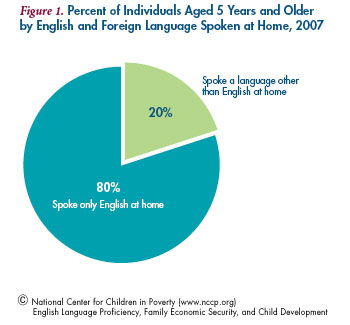
A 2010 report by the U.S. Census Bureau highlights two trends in the United States population with implications for social policy. First, the number of United States residents aged 5 years and older who speak a language other than English at home has more than doubled since 1980. Second, fewer than half of this group is fully proficient in English. These trends require specific policy action to support optimal child well-being.
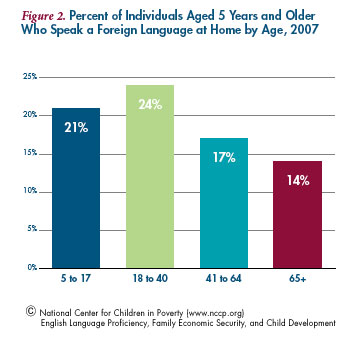
Based on results from analysis of the 2007 American Community Survey, the Census Bureau report finds that a large majority of the population aged 5 and older in the United States (80 percent) speaks only English at home (see Figure 1). However, the number of individuals who speak a language other than English at home more than doubled between 1980 and 2007. The magnitude of this growth is four times greater than the nation’s population growth. The number of individuals who spoke a language other than English at home increased 140 percent from approximately 23.1 million in 1980 to 55.4 million in 2007 (see Table 1). By contrast, the overall U.S. population grew 34 percent during this period. The findings also suggest that the prevalence of foreign-language speakers is highest among the younger ages. As shown in Figure 2, 21 percent of children aged 5 to 17 and 24 percent of adults aged 18 to 40 spoke a language other than English at home, compared to 17 percent of adults aged 41 to 64 and 14 percent of adults aged 65 and older.
Table 1. Number of Individuals Aged 5 Years and Older and Percentage Change by Language Spoken at Home, 1980, 1990, 2000, and 2007 (in millions)
| 1980 | 1990 | 2000 | 2007 | Percent Change 1980-2007 | |
| Total population | 210 | 230 | 262 | 281 | 34% |
| Spoke only English at home | 187 | 199 | 215 | 226 | 21% |
| Spoke a language other than English at home | 23 | 32 | 47 | 55 | 140% |
Note: Sample restricted to individuals aged 5 years and older.
Source: Shin and Kominsky, 2010.
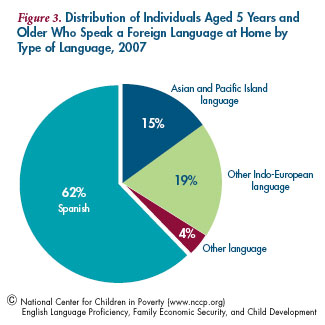
Figure 3 shows that Spanish speakers account for the largest share of the population who spoke a language other than English at home in 2007 (62 percent). Further, while there were eight languages spoken at home that more than doubled between 1980 and 2007, the largest numerical increase of foreign-language speakers was among those who spoke Spanish. By 2007 the number of Spanish speakers had grown by more than 23.4 million.
The number of residents with low English proficiency is also increasing
Increased linguistic diversity contributes to the United States’ global competitiveness and our ability to integrate culturally and economically. Speaking a parent’s native language other than English at home can have a positive effect on children’s English literacy development, and bilingual language skills can positively affect children’s educational achievement. The Census Bureau’s report, however, highlights a sobering statistic: millions of residents of the United States are not proficient in the English language. In fact, the Census Bureau classifies five percent of US households as linguistically-isolated. A linguistically-isolated household is one where no one in the home above the age of 14 speaks English only or speaks a second language and speaks English well. In 2007, 24.5 million individuals reported that they spoke English less than “very well.” The proportion of individuals who are less than proficient in English is especially high for those who speak Spanish at home – at 47 percent – and those who speak Asian and Pacific Island languages, at 49 percent.
The number of individuals with inadequate English-language skills is rapidly increasing, according to a second report from the Government Accountability Office (GAO) that analyzes trends not tracked in the Census report. The GAO study finds that adults who speak English less than “very well” rose 21.8 percent between 2000 and 2007, to about 22 million. The study also reports that the largest numbers of adult residents with limited English-language proficiency in 2007 lived in six large immigrant “gateway” states: California, Florida, Illinois, New Jersey, New York and Texas. A second group of states, however – Alaska, Arizona, Arkansas, Georgia, Nevada and Tennessee – posted the highest growth rates in this population during the 2000 to 2007 period. These 12 states account for 75 percent of the national adult population with limited English-language proficiency.
Substantial numbers of children also struggle with English language proficiency. The proportion of children aged 5 to 17 who spoke a language other than English at home increased from 3.8 million in 1979 to 10.9 million in 2008 (9-21 percent). Those who spoke a language other than English at home and who spoke English with difficulty rose from three percent in 1979 to six percent in 2000 and then stabilized at around five percent between 2001 and 2007. Among these children, Latino/Hispanics (17 percent), Asians (16 percent), and Pacific Islanders (8 percent) were the largest groups. Over 75 percent of children who had difficulty with English spoke Spanish at home (more than 2 million children). Within groups of Latino school-age children, those of Central American and Mexican descent struggled most (20 percent and 19 percent respectively). Among Asian-Pacific Islander children, those of Korean, Japanese and Vietnamese descent had the most difficulty (20 percent respectively). Child English language proficiency also varies considerably by state. For example, in Arizona, California and Texas, more than 10 percent of school-aged children who spoke a language other than English at home also reported having difficulty speaking English. Income also proved to be a contributing factor. Children from poor or low-income households were more likely than their non-poor peers who spoke a language other than English at home to experience difficulty with English (10 percent and eight percent vs. three percent).
English-language proficiency is important for family economic security and child well-being
The results from the data on trends in English language proficieny take on added significance in light of research which suggests that English language proficiency has important implications for children’s well-being in the United States. While the mechanisms by which English language proficiency matters for children continue to be investigated, current research points to English language proficiency as an important factor for both parents and children in at least three ways. First, limited English language proficiency among both parents and children is associated with poor educational outcomes among children. Parents’ limited English language proficiency can hamper their ability to communicate effectively with their children and help with their children’s English language-related homework. So-called ‘language minority’ children and youth (such as those who speak English as their second language) have difficulty in school. Based on reports from 41 states, only about 19 percent of English language learners scored above the state-established norm in English reading comprehension assessments; and half of those who speak English with difficulty failed to complete high school. Second, poor English language skills are associated with limited access to health and mental health care and other social services where there are inadequate culturally and linguistically competent services. Some research shows that parents with limited English language proficiency were three times more likely to report having a child with fair/poor health status, yet significantly less likely to bring a child for needed medical care. Further, parents who do not speak English as a primary language reported having more difficulties in accessing mental health services for their children. Finally, English language proficiency among parents is an important economic asset that is associated with increased workforce participation, significantly higher earnings, and economic mobility, and thus contributes to the amount of family resources available to invest in children.
Public funding and service capacity for teaching English to non-English speakers has lagged far behind
Public funding and service capacity for programs teaching English to speakers of other languages (ESOL) lags far behind the increase in the number of individuals and families that are likely to benefit. Even as the number of adults with inadequate English-language skills rose by more than one-fifth, the GAO report finds that national enrollment in English-language programs funded by federal government’s Adult Education State Grant Program (the principal federal program supporting English proficiency improvement for non-native speakers) remained virtually unchanged between one to 1.2 million people for each reporting year from 2000 to 2007. Appropriations for this program have also remained unchanged, at about $560 million annually in recent years. Since 2001, Even Start, another important program with separate funding, has experienced a 75 percent appropriations cut to $66.5 million in 2010. This program supports family literacy services for low-income parents with limited English proficiency and their children. Over 11 million individuals are non-literate in English. Moreover newer waves of non-English-speaking immigrants with lower levels of literacy highlight the need for such programs. According to the latest data made available from the United States Department of Education, the number of individuals served by Even Start (for all literacy services, including English learning) fell by more than half to 45,693 as funding was cut by more than 70 percent between the 2005 to 2006 and 2007 to 2008 school years.
While other federally-funded programs permit funds to be used for adult English language instruction, enrollment in English-proficiency classes using these funds is not tracked. In addition, some states and localities (such as California, New Jersey, Illinois and New York City) provide substantial additional monies for this purpose. But even counting these additional resources, significant and rising unmet demand exists for English language learning services according to government officials interviewed by GAO in the 12 states with the highest concentration of individuals with limited English language proficiency. Officials representing eight of the 12 states reported higher demand for these services, while three reported unchanged demand. Immigrants’ fear of accessing government services is among the factors state officials cite as possibly constraining enrollment in federally-funded language programs.
New York: A Case Study Example
New York is linguistically diverse and has one of the highest percentages of foreign-language speakers
Among the 12 states with large or rapidly-growing populations with limited English language proficiency, New York stands out for its extraordinary linguistic diversity concentrated in New York City. Among the nation’s metropolitan areas, New York City ranks the highest or second-highest in the share of residents who speak 22 of the 30 languages (depending on the language) analyzed by the Census Bureau. Statewide, the percentage of foreign-language speakers aged 5 years and older is higher than the national average – 28.9 percent versus 19.7 percent, according to the Census Bureau report. In addition, 13.2 percent of the population aged 5 years and older in New York speaks English less than “very well” compared with 8.7 percent of the U.S. population.
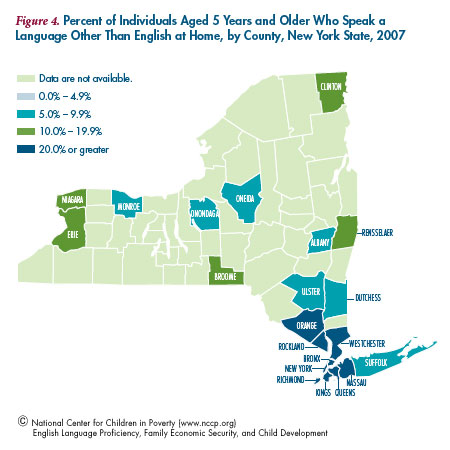
Figure 4 shows that the proportion of families who speak a language other than English at home is unevenly distributed across New York State with a majority residing in the linguistically diverse community of New York City. Indeed, 55 percent of individuals aged 5 years and older living in Bronx County speak a language other than English, and in Queens and Kings County, the story is similar: 55 percent and 47 percent, respectively. Non-English speakers in counties outside of New York City pose a significant presence, specifically in suburban Rockland (34 percent) and Westchester (30 percent) counties.
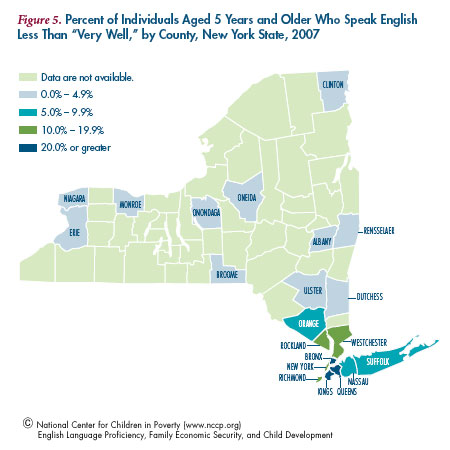
As would be expected, statewide patterns with respect to English language proficiency are very similar. Figure 5 shows a high concentration of residents with limited English language proficiency in New York City. Strikingly, 29 percent of individuals aged five years and older who reside in Queens County speak English less than “very well.” Similarly, approximately one-quarter of individuals in both Bronx (25 percent) and Kings counties (24 percent) speak English less than “very well.” Counties outside of New York City are also home to significant numbers of residents with limited English language proficiency, particularly in suburban Rockland County (15 percent) and Westchester County (12 percent).
New York’s unique linguistic diversity and continuing importance as an immigrant gateway has drawn research attention to the state’s English language learning needs and how well they are being met. A recent study by two New York State public policy research centers exposed an alarming gap between the potential demand for English-language education and the supply of publicly-funded classes. The researchers found that although 1.8 million working-age adults with limited English language proficiency resided in New York State in 2008, only 87,000 student slots were available in state-administered adult ESOL programs in 2006 (the latest year for which data are available). Evidently, much of the need for English-language instruction is related to continuing large inflows of foreign immigrants into the state: the rate of growth of foreign-born residents during the 2000 to 2007 period exceeded population growth in 12 of New York State’s 15 largest counties, including all New York City boroughs except for Manhattan.
Policy implications and recommendations
Given the large continuing budget deficits forecast for the federal government and the serious fiscal plight faced by many states and municipalities, prospects are dim for significant increases in governmental support for English-language instruction to speakers of other languages. Yet the clearly-documented returns to increasing English language proficiency for both individual children and adults and society as a whole (in the form of civic integration, higher productivity and a stronger tax base) make a strong argument for public investment in English-language skills. Beyond additional spending, the GAO emphasizes the need for better data-gathering and information-sharing among the federal agencies funding English-language learning (principally, the Departments of Labor, Education, and Health and Human Services) to identify best practices and efficiencies in instruction. For school-aged children, the US Department of Education administers the Bilingual Education Act, and the federal education program is specially designed for children with limited English language proficiency. Bilingual education projects utilize the native language of children for teaching English language. Research shows that students who are taught in bilingual education programs perform better than students with limited English language proficiency in all-English classrooms. We strongly support a national commitment to providing affordable and effective English-language learning opportunities, including ESOL and bilingual education, for all United States residents who seek this instruction.
Research also points to the benefits accrued through culturally and linguistically competent services and supports, especially in health care settings. Research suggests that having bilingual clinicians and trained health care interpreters contributes to the improved adherence to medical regimens, reduced emergency care visits, and increased physician office visits among patients with limited English language proficiency. By contrast, poor language access in health care results in sub-optimal care, and negative health outcomes such as increased morbidity and premature mortality. Culturally and linguistically competent services contribute to improved access and quality and ultimately the well-being of families with children with limited English language proficiency. We strongly support significant federal investments to improve cultural and linguistic competence as proposed in the Patient Protection and Affordability Act. Specifically, provisions related to language access, collection, analysis and reporting of disparities based on race, ethnicity or limited English language proficiency and developing cultural and linguistic competency among service providers must be fully funded and robustly implemented.
Endnotes
1. Shin, Hyon B.; Kominski, Robert A. 2010. Language Use in the United States: 2007. American Community Survey Reports, ACS-12. Washington, DC: U.S. Census Bureau. Accessed May 19, 2010 from http://www.census.gove/prod/2010pubs/acs-12.pdf.
2. August, Diane; Shanahan, Timothy. 2006. Developing Literacy in Second-Language Learners: Report of the National Literacy Panel on Language-Minority Children and Youth. Mahwah, NJ: Lawrence Erlbaum and the Center for Applied Linguistics. Accessed May 19, 2010 from http://www.cal.org/projects/archive/nlpreports/Executive_Summary.pdf.
3. Lutz, Amy. 2007. Barriers to High School Completion Among Immigrant and Later-Generational Latinos in the USA: Language, Ethnicity and Socioeconomic Status. Ethnicities 7(3): 3203-342.
4. Liu, L. K.; Benner, A.D.; Lau, A. S.; Kim, S. Y. 2009. Mother-Adolescent Language Proficiency and Adolescent Academic and Emotional Adjustment among Chinese American Families. Journal of Youth and Adolescence 38(4): 572-586.
5. US Census Bureau. 2008. Linguistic Isolation. Table S1602. American FactFinder. Accessed June 1, 2010 from http://factfinder.census.gov
6. Government Accountability Office. 2009. English Language Learning: Diverse Federal State Efforts to Support Adult English Language Learning Could Benefit from More Coordination. Report to the Ranking Member, Subcommittee on Children and Families, Committee on Health, Education, Labor, and Pensions, U.S. Senate. Accessed May 19, 2010 from http://www.gao.gov/new.items/d09575.pdf.
7. National Center for Education Statistics. 2010. The Condition of Education. Accessed June 1, 2010 from http://nces.ed.gov/pubsearch/pubsinfo.asp?pubid=2010028
8. National Center for Education Statistics. 2009. The Condition of Education.Accessed May 19, 2010 from http://www.nces.ed.gov/programs/coe/2009/section1/indicator08.asp.
10. Shields, Margie K.; Behrman, Richard E. 2004. Children of Immigrant Families: Analysis and Recommendations. The Future of Children 14(2): 4-15.
11. Kindler, A. 2002. Survey of the States’ Limited English Proficient Students and Available Educational Programs and Services. Washington, DC: National Clearinghouse for English Language. Accessed May 19, 2010, from http://www.ncbe.gwu. edu/ncbepubs/seareports/99-00/sea9900.pdf.
13. Hernandez, Donald J. 2004. Demographic Change and the Life Circumstances of Immigrant Families. The Future of Children 14(2): 17-47.
14. Flores, G. F.; Abreu, M.; Brown, V.; Tomany-Korman, S. C. 2005. How Medicaid and the State Children’s Health Insurance Program Can Do a Better Job of Insuring Uninsured Children: The Perspectives of Parents of Uninsured Latino Children. Ambulatory Pediatrics 5(6): 332-340.
15. Flores, G. F.; Abreu, M.; Tomany-Korman, S. C. 2005. Limited English Proficiency, Primary Language at Home, and Disparities in Children’s Health Care: How Language Barriers Are Measured Matters. Public Health Reports120(4): 418-430.
16. Sue, Stanley; Fujino, D. C.; Hu, Li-tze; Takeuchi, D. T.; Zane, N. W. S. 1991. Community Mental Health Services for Ethnic Minority Groups: A Test of the Cultural Responsiveness Hypothesis. Journal of Consulting and Clinical Psychology 59 (4): 533-540.
18. Chiswick, B.R.; Miller, P.W. 2009. Earnings and Occupational Attainment Among Immigrants. Industrial Relations 48(3): 454-465.
19. Rivera-Batiz, Francisco L. 1990. English Language Proficiency and the Economic Progress of Immigrants. Economics Letters 34(3): 295-300.
20.Keenan, Cheryl. 2009. Statement by Cheryl Keenan, Director of Adult Education and Literacy, Office of Vocational and Adult Education, Before the House Education and Labor Subcommittee on Higher Education, Lifelong Learning, and Competitiveness. Accessed May 20, 2010 from http://www2.ed.gov/about/offices/list/ovae/pi/AdultEd/ae-testimonyovae- 090224.pdf.
21. Baer, Justin D.; Kutner, Mark A.; Sabatini, John P. 2009. Basic Reading Skills and the Literacy of American’s Least Literate Adults: Results from the 2003 National Assessment of Adult Literacy (NAAL) Supplemental Studies. Institute of Education, Washington, DC: US Department of Education, National Center for Education Statistics.
22.Kutner, M.; Greenberg E.; Jin, Y.; Boyle, B.; Hsu, Y.; Dunleavy, E. 2007. Literacy in Everyday Life: Results from the 2003 National Assessment of Adult Literacy. U.S. Department of Education. Washington, DC: National Center for Education Research.
23. U.S. Department of Education. Even Start Funding Status. Accessed May 19, 2010 from http://www2.ed.gov/programs/ evenstartformula/funding.htm. English Language Proficiency, Family Economic Security, and Child Development 11
24. U.S. Department of Education. 2009. CSPR Summary Report. Accessed May 19, 2010 from http://www2.ed.gov/ programs/mep/resources.html.
25. Center for an Urban Future. 2010. An Action Agenda for ESOL. Accessed May 19, 2010 from http://www.nycfuture.org/ images_pdfs/pdfs/ESOLActionAgenda.pdf.
26. State-administered programs integrate both federal and state funds.
27. Osorio-O’Dea, Patricia. 2001. Congressional Report Services (CRS) Report for Congress, Bilingual Education: An Overview. Washington DC: The Library of Congress. Accessed May 27, 2010 from www.policyalmanac.org/education/archive/bilingual.pdf.
28. Krashen, Stephen; McField, Grace. 2005. What Works? Reviewing the Latest Evidence on Bilingual Education. Language Learner(November/December 2005): 7-10. Accessed May 2010 from http://www.elladvocates.org/documents/RCN/ Krashen-McField.pdf
29. Brach, Cindy; Fraser, Irene; Paez, Kathy. Crossing the Language Chasm: An In-Depth Analysis of What Language- Assistance Programs Look Like in Practice. Health Affairs 24(2): 424-434.
30. Galbraith, A.A., et al. 2008. Language Disparities and Timely Care for Children in Managed Care Medicaid. The Journal of Managed Care 14(7): 417-426.
31. Baker, D.W; Wolf, M.S.; Feinglass, J.; Thompson, J.A.; Gazmararian, J.A.; Huang, J. 2007. Health Literacy and Mortality Among Elderly Persons. Archives of Internal Medicine 167(14): 1503-9.
32. Perez-Stable, Eliseo J. 2007. Language Access and Latino Health Care Disparities. Medical Care 45(11): 1009-11.
33. Fiscella, Kevin; Epstein, Ronald M. 2008. So Much to Do, So Little Time: Care for the Socially-Disadvantaged and the 15 Minute Visit. Archives of Internal Medicine 168(17): 1843-54.
34. Sue, S.; Zane, N; Hall, G. C. N.; Burger, L. K. 2009. The Case for Cultural Competency in Psychotherapeutic Interventions. Annual Review of Psychology 60: 525-548.
35. “The Patient Protection and Affordability Act of 2010” (PL 111-148), Title V, Section 500118.
